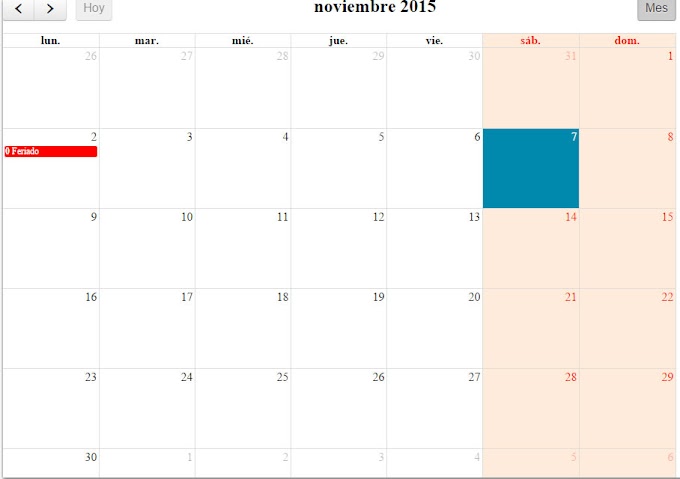FullCalendar es un plugin JQuery, para visualizar eventos en un calendario.
Hoy les traigo un ejemplo práctico usando JSF y FullCalendar, Crearemos una funcionalidad donde estableceremos los días feriados de un mes, para esto nos conectaremos a una base de datos y obtendremos los días feriados de esta tabla.
Para este ejemplo usaremos NetBeans como IDE, creamos una aplicación Web.
Luego nos descargamos el plugin de JQuery en http://fullcalendar.io/download/
Para este caso en nuestro proyecto crearemos una carpeta resources donde copiaremos el código de full calendar :
El siguiente paso es importar las clases necesarias para visualizar nuestro calendario
<h:heady >
<title >Full Calendar</title >
<link href='resources/calendario/fullcalendar.css' rel='stylesheet' />
<link href='resources/calendario/fullcalendar.print.css' rel='stylesheet' media='print' / >
<h:outputScript library="calendario/lib" name="jquery.min.js" />
<h:outputScript library="calendario/lib" name="moment.min.js" />
<h:outputScript library="calendario" name="fullcalendar.min.js" / >
<h:outputScript library="calendario" name="lang-all.js" / >
Estableceremos un poco de diseño para nuestro calendario
<style>
#calendar {
max-width: 900px;
margin: 0 auto;
}
.fc-sat, .fc-sun {
background-color: #FFEBDA;
color: red;
}
.cuerpoBody {
color: black;
}
.fc-unthemed .fc-today {
background: #0088AD;
color:white;
}
.fc-event {
border: red;
background-color: red;
font-size: 12px;
}
</style>
Ahora configuramos nuestro Calendario
<script>
$(document).ready(function () {
var currentLangCode = 'es';
var hoy = new Date();
var dd = hoy.getDate();
var mm = hoy.getMonth()+1; //hoy es 0!
var yyyy = hoy.getFullYear();
hoy = yyyy+'-'+mm+'-'+dd;
$('#calendar').fullCalendar({
header: {
left: 'prev,next today',
center: 'title',
right: 'month'
},
defaultDate: hoy,
lang: currentLangCode,
selectable: true,
selectHelper: true,
editable: true,
eventLimit: true,
events: "servlet/CalendarioDao"
});
});
</script>
En esta primer parte establecemos la fecha actual:
var currentLangCode = 'es';
var hoy = new Date();
var dd = hoy.getDate();
var mm = hoy.getMonth()+1; //hoy es 0!
var yyyy = hoy.getFullYear();
y al momento de cargar nuestro calendario tome por defecto la fecha actual en la propiedad defaultDate, la propiedad events no va permitir hacer un llamado al servlet, el cual consulta a la base de datos y establece los días feriados a nuestro calendario.
Servlet Calendario/Dao
protected void doGet(HttpServletRequest request, HttpServletResponse response) throws ServletException, IOException {
List lst = new ArrayList<>();
List lst2 = DiasFeriados.getFeriados();
for (DiasFeriados f : lst2) {
DiasFeriados df = new DiasFeriados();
String m = (String.valueOf(f.getMes()).length() == 1) ? "0" : "";
String d = (String.valueOf(f.getDia()).length() == 1) ? "0" : "";
df.setStart(f.getAnnio() + "-" + m + f.getMes() + "-" + d + f.getDia());
df.setEnd(f.getAnnio() + "-" + m + f.getMes() + "-" + d + f.getDia());
df.setTitle(f.getTitulo());
df.setAllDay(false);
lst.add(df);
}
Gson gson = new Gson();
String eventoJSON = gson.toJson(lst);
response.setContentType("application/json");
response.setCharacterEncoding("UTF-8");
PrintWriter out = response.getWriter();
out.write(eventoJSON);
}
Para la respuesta de nuestro Servlet usaremos JSON, y usaremos la Biblioteca Gson para la generación de este.
Recorremos los registros que nos devuelve el método getFeriados() y seteamos los campos para establecer los días feriados en nuestro campos.
Método getFeriados
public static Listpor último hacemos el llamado de nuestro calendariogetFeriados() { List lista = new ArrayList<>(); Connection con = null; ResultSet rs = null; PreparedStatement ps = null; try { con = DBConnector.getInstance().getConnection(); String query = "select dia,mes,annio,titulo " + "from dias_feriados " + "where estado ='A'"; ps = con.prepareStatement(query); rs = ps.executeQuery(); while (rs.next()) { DiasFeriados df = new DiasFeriados(); df.setDia(rs.getInt("DIA")); df.setMes(rs.getInt("MES")); df.setAnnio(rs.getInt("ANNIO")); df.setTitulo(rs.getString("TITULO")); lista.add(df); } } catch (Exception e) { e.printStackTrace(); } finally { try { if (rs != null) { rs.close(); } if (ps != null) { ps.close(); } if (con != null) { con.close(); } } catch (Exception e2) { e2.printStackTrace(); } } return lista; }
<div id="calendar" style="margin-top: 5%"></div>Código Fuente
clave: www.codigosdelaweb.com




1 Comentarios
Me fue de mucha ayuda, gracias
ResponderEliminar